Looking forward to new skills
By the age of 4-5 months, the child can already do a lot on his own - raise his head, roll over, look at toys. And parents want to see the baby sitting cutely in his crib and playing with rattles on his own. In the wake of such a desire, the child’s attempt to grab the mother’s outstretched finger and pull her towards him in the same way as a favorite toy is perceived as a desire to sit upright. Naturally, parents have a question: should they help when a child tries to sit up at 4-5 months?
Official approach
According to the World Health Organization, a child can begin to sit without support from 4 to 9 months. However, domestic pediatricians do not recommend sitting down a child until the age of 6 months, even if it seems to parents that the child is trying to sit down at 4 months. In order to maintain your body in a sitting position, a sense of balance is required, and this develops simultaneously with the development of gross motor skills. Therefore, even a 6-month-old child, whose central nervous system is still developing, is characterized by a feeling of instability in an upright state.
The most important thing is to accept that every child is unique and develops at their own pace. The speed at which new physical skills are learned depends on both the child’s temperament and weight. A thin, flexible baby may be in a hurry to be able to observe the world around him from a sitting position. And a chubby, calm child may well be content with looking at the toys above the crib for a longer time.
Most babies begin to sit well with a little help between 7 and 9 months of age. But there are children who sit down at the age of 1 year, without any delay in mental and physical development.
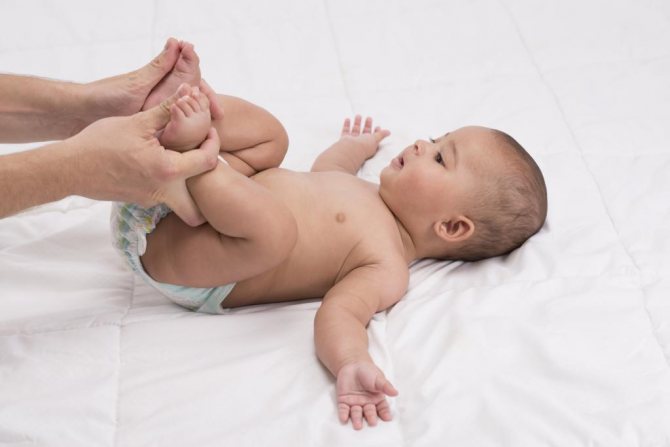
What to do if the child does not sit
First of all, don’t worry. The boundaries of the norm are wide, and if your child refuses to hold his back upright even at 6–7 months, he has every physiological right to do so.
Concern is justified only in the following cases: Baby milestones: Sitting:
- if by about 4 months you have not even noticed attempts to raise your head and hold it upright;
- if the child holds his head, but does not try to raise himself on his arms from a position on his tummy;
- The baby is already 9 months old, but he still has not learned to sit without support.
However, even a lag behind these key “reference points” is not an indication that there is something wrong with the child. Children develop individually. And for example, those of them who were born prematurely may be slightly delayed in development compared to their peers. In any case, your pediatrician will give you more accurate information.
Myths and reality
Nowadays, the conjectures that used to intimidate parents who placed their children upright too early are becoming a thing of the past: namely, the myth that if a girl tries to sit up at 4 months, she will certainly have a tilted uterus and problems with childbearing. This is wrong. In fact, if a girl or boy tries to sit up at 4 months, they can suffer the same unpleasant consequences due to the heavy load on the fragile spine - this includes scoliosis, radiculitis, and other disorders of the musculoskeletal system.
The main task of parents in raising babies under one year old is to create a favorable environment in which children can fully develop. To do this, it is necessary to provide a safe space and monitor the health and well-being of the children. In the absence of neurological diseases and other disorders, children strive to learn new skills without additional incentives from adults.
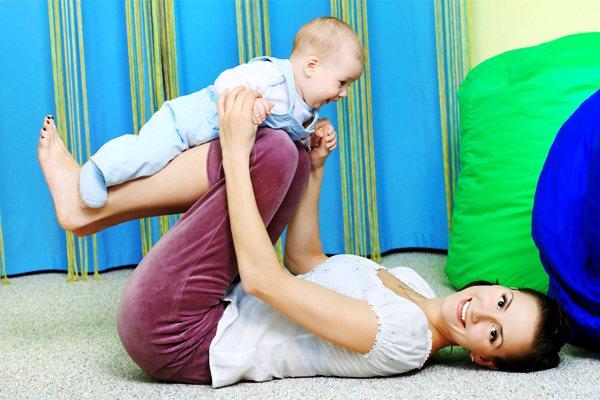
What to do if the child tries to sit up?
For the most impatient and curious kids, you can offer several exercises that will help strengthen their back and prepare it for gatherings.
- Place the baby on a hard surface in different positions more often. Pay special attention to placing on the tummy. It is by lying on his stomach, raising his head and shoulders, that the baby strengthens the muscles necessary for sitting. And if you put a toy in front of your child, he will reach for it, and the exercise will be even more effective.
- Place the baby on his tummy, lift him up, supporting him under the chest and under the shins. The child's legs should rest against the adult's body. Hold it in this position for a few seconds. The child's back and buttocks will tense, and the muscles will receive the necessary load.
- Many babies like to rise from a lying position on their back, holding the hands of an adult. This is also a good workout. The child, lying on his back, is asked to grab onto the fingers of his mother or father. And if the baby expresses a desire, allow him to rise for a couple of seconds.
- We must remember that the baby is in such a hurry to sit down because he is very interested in everything that is happening around him. Therefore, while the baby cannot sit, it is worth taking him in your arms more often and showing him everything that interests him.
All these and other exercises should be discussed with the pediatrician and asked for advice, because with each month of the baby’s life the set of exercises suitable for him changes. In addition, only a doctor will be able to accurately determine which muscle group of the child needs special attention.
should be carried out when the baby is alert, cheerful and in the mood for physical activity.
Of course, your baby won’t want to exercise on an empty stomach. But you shouldn’t disturb him immediately after eating. The optimal time for gymnastics is half an hour after eating.
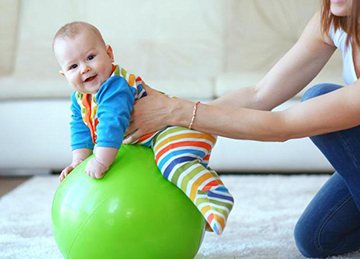
Before performing exercises, the room must be ventilated.
The surface on which the child will lie must be sufficiently hard and warm. A changing table covered with a warm blanket is ideal.
It must be remembered that if the baby is lightly dressed during gymnastics, he may be cold at the recommended 18-20 °C.
Therefore, you should carefully monitor the mood and well-being of the baby and, if necessary, dress him warmly or increase the temperature in the room by 2-3 degrees.
Regular water treatments also help strengthen your back muscles.
What can negatively affect a child's health?
When a 4-month-old child tries to sit up, parents sometimes take actions that are not recommended by pediatricians. It is unsafe for a child’s health to sit on pillows, as he falls in different directions, as well as to be carried in a “kangaroo” type carrier, where he sits and the entire load goes on the spine. It is also forbidden to place the baby in a high chair or stroller with a vertical back position; it is permissible only in a reclining position. Not only the baby’s unprepared spine, but also compressed internal organs can suffer from the load. The natural curves of the spine, which will support posture, are formed gradually, so the spine of children under six months is not intended for vertical positions and allows children to only lie down.
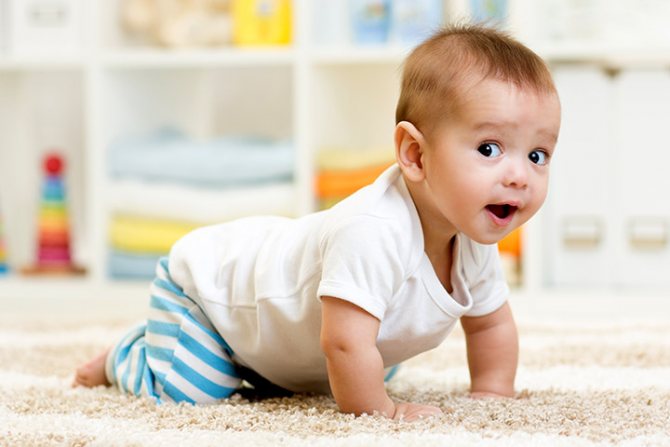
How to understand that your child is ready to sit
Children are born weak: their muscles initially cannot hold the body in an upright position. But every day they develop and become stronger.
The first sign that a child will soon learn to sit is the ability to confidently control the position of his head.
The fact that the baby has learned to hold his head upright and turn it in different directions means that the muscles of his neck and back have become sufficiently strong. As a rule, this skill is acquired at the age of 5–6 months. The ability to sit down, holding not only your head but also your back upright, is literally one step away.
When is the baby ready to sit?
The baby is ready to explore the world around and get acquainted with new toys within a couple of weeks after birth. However, with motor skills the situation is somewhat different. It is quite possible that a child at 4 months is trying to sit up while holding onto a support. A healthy baby will definitely learn to sit, stand and walk by the hand. It is important not to rush things and allow the child’s muscles to adapt to new tasks. Parents can determine the child’s readiness to sit by a set of signs: the baby can already stand on all fours and at the same time reach with his hand to objects, as well as bend his legs. The most successful option would be for a child to be able to crawl on all fours, since crawling is the best way to prepare the back muscles for vertical loads.
The baby will be able to make independent attempts to sit up when he is able to pull himself up with his arms. After this, the child can turn on his side and, leaning on his hand, lower himself onto his butt. At first the position will be unstable and the baby will fall on its side, but over time it will learn to maintain balance.
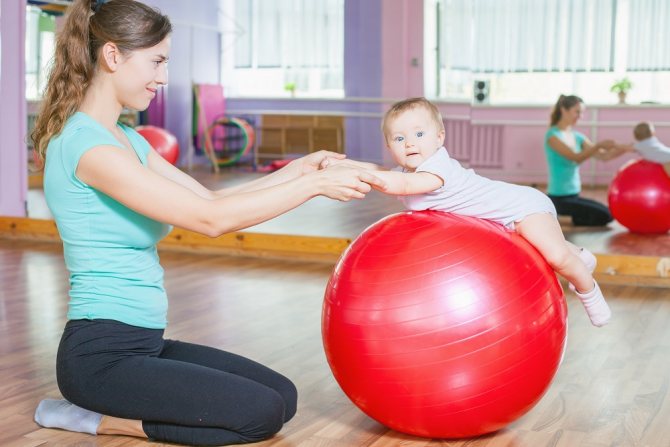
When does the baby start to sit?
Most children begin to sit confidently around 6 months of age. Infant and toddler health. Although the boundaries of the norm, as often happens, are quite blurred. Baby milestones: Sitting - some people make attempts as early as 4 months, and others closer to 7 months.
True, sitting does not mean sitting down. Most likely, at first you will have to help your son or daughter into the desired position (do not do this before the child learns to hold his head up!).
Sit your baby so that he has support. For example, surround it with pillows. Or sit him in a high chair for feeding - but just be sure to make sure he doesn’t fall out.
Even children who seem to have mastered sitting often fall over in the first few weeks after learning a new skill. Sometimes - simply because they have become uninterested in maintaining an upright position. Take this into account and do everything to prevent your child from hitting his head when falling.
By 7–8 months, almost all children sit up independently from any position - lying on their back, stomach, side - and confidently maintain balance with a vertical back.
How to help your baby?
What can parents do if their baby is trying to sit up at 4 months? First of all, you should remember the benefits of gymnastics. Daily exercises will strengthen the back muscles and help the child better master his arms and legs and feel the capabilities of his body. An excellent exercise for developing the muscles of the shoulder girdle would be exercises on a fitball, for example, rolling a baby from one barrel to another. While awake, your baby should often be placed on his tummy so that he can practice getting up on all fours and reaching for hanging toys. An “obstacle course” will also be an interesting activity, when the baby needs to overcome a lying pillow in order to reach his favorite bright toy.
When the time comes, the baby will learn to sit up on his own and will be ready for new achievements. And parents don’t need to worry if a child is trying to sit up at 4 months; you can easily help him master this important skill.
How to teach a child to sit
How to teach a child to sit? It’s very simple: you need to develop his muscles well enough. That's all! You need to focus your efforts only on this. Let us repeat once again: forcibly holding a child in a sitting position is unacceptable!
Some useful exercises for teaching a child to sit are:
To teach your child to sit, strengthen his abdominal muscles. This task can and should be taken up almost from the birth of the baby. Well, not from birth, of course, but as soon as he learns to grab his fingers and starts trying to rise. Let him do this as often as possible! A complicating technique is to lift the baby by the arms in a “crosswise” position. Let the baby lie on his back, give him your right hand (it will turn out just “crosswise”) and, lightly pressing his legs above the knees to the changing table or sofa, invite the baby to “sit down”. That is, let the baby rise to 45°, hold for a minute or two (depending on age) and return to the starting position. If he wants, let him repeat it all over again.

Source: Shutterstock
To teach your child to sit, train the lateral abdominal muscles. Place the baby in your arms at an angle of 45-60° (not perpendicular). Give your baby your thumb and clasp his hand with all your other fingers. Make circular movements with your hand, forcing the baby to lean to the sides and back and forth. Watch the baby’s reaction: if the facial expression is satisfied, continue the exercise. The baby expresses dissatisfaction - stop.
We train the back muscles. An excellent exercise for developing the back muscles, which are absolutely necessary for a child to learn to sit, is the “airplane”. Place the baby in your arms on the tummy, one of your hands supports the baby's chest, the other supports the legs. Let the baby rest his legs on your chest, while he will reflexively have a desire to tense his back and neck muscles. The safety rule for any exercise with a baby remains the same - as soon as the baby shows his dissatisfaction, the exercises stop.

Source: Shutterstock











